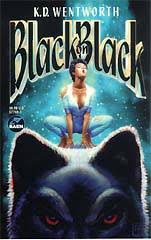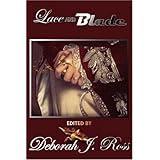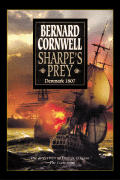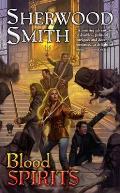I've been wondering how I can write about K. D. Wentworth's marvelous, touching story, "The Garden of Swords." I put off this essay until the last, and you'll see why. In the story, a young scullery maid finds solace in the castle garden, in which the slain opponents of the power-mad baron are buried. This is a magical garden, and the ghosts of those swordsmen (and swordswoman!) become the girl's friends, confidantes, teachers, and on occasion her protectors. When I read it over, I feel as if Kathy's ghost is there, too, welcoming us all into her special realm of enchantment and friendship.
I met K. D. Wentworth back in the days when GEnie was a vibrant and interconnected community. I don't know how well the site worked for others, but we sf/f writers took to the bulletin board topics like ducks to supernovae. The various round tables were like rooms in an ongoing convention, with some silly chat and some serious conversations. Professional relationships formed and deepened, and many beginning writers found support and encouragement there. Alas, GEnie with its text-only format went the way of the dinosaur as the clocks ticked over into 2000, but many of the friendships are still going strong.
 We met in person a few times, although I did not frequently travel outside the West Coast and she hailed from Oklahoma. I found her as charming and thoughtful in person as online. A number of her short fiction pieces were Nebula Award finalists (the novelette, "Kaleidoscope" 2008, and "Burning Bright" 1997, "Tall One" 1998, and "Born Again" 2005) have been Nebula award finalists. I knew she was one of the writers I wanted for The Feathered Edge.
We met in person a few times, although I did not frequently travel outside the West Coast and she hailed from Oklahoma. I found her as charming and thoughtful in person as online. A number of her short fiction pieces were Nebula Award finalists (the novelette, "Kaleidoscope" 2008, and "Burning Bright" 1997, "Tall One" 1998, and "Born Again" 2005) have been Nebula award finalists. I knew she was one of the writers I wanted for The Feathered Edge.
True to her high professional standards, she sent me a story that is extraordinary. In clear prose and straightforward narrative, she managed to reach into my heart. "In the Garden of Swords" fits loosely within the theme of elegant romantic fantasy, a ghost-story-with-a-twist, sword and sorcery, but it is also a story of how love and kindness, strength and truth, transcend death. Whenever I re-read it, I hear Kathy's literary voice still spinning out tales of wonder and hope.
Kathy died in April 2012. I had no idea she was so ill. We weren't close, except in the sense that all writers who love fantasy and whose professional paths cross are close.
Wherever you are, Kathy, thank you for your marvelous stories. The world is richer for having had you in it.
I met K. D. Wentworth back in the days when GEnie was a vibrant and interconnected community. I don't know how well the site worked for others, but we sf/f writers took to the bulletin board topics like ducks to supernovae. The various round tables were like rooms in an ongoing convention, with some silly chat and some serious conversations. Professional relationships formed and deepened, and many beginning writers found support and encouragement there. Alas, GEnie with its text-only format went the way of the dinosaur as the clocks ticked over into 2000, but many of the friendships are still going strong.
True to her high professional standards, she sent me a story that is extraordinary. In clear prose and straightforward narrative, she managed to reach into my heart. "In the Garden of Swords" fits loosely within the theme of elegant romantic fantasy, a ghost-story-with-a-twist, sword and sorcery, but it is also a story of how love and kindness, strength and truth, transcend death. Whenever I re-read it, I hear Kathy's literary voice still spinning out tales of wonder and hope.
Kathy died in April 2012. I had no idea she was so ill. We weren't close, except in the sense that all writers who love fantasy and whose professional paths cross are close.
Wherever you are, Kathy, thank you for your marvelous stories. The world is richer for having had you in it.







